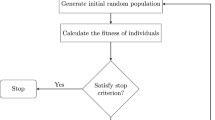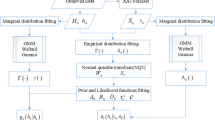Abstract
In the water resources field, there are emerging problems such as temporal changes of data and new additions of water sources. Non-mixture models are not efficient in analyzing these data because these models are developed under the assumption that data do not change and come from one source. Mixture models could successfully analyze these data because mixture models contain more than one modal. The expectation maximization (EM) algorithm has been widely used to estimate parameters of the mixture normal distribution for describing the statistical characteristics of hydro meteorological data. Unfortunately, the EM algorithm has some disadvantages, such as divergence, derivation of information matrices, local maximization, and poor accuracy. To overcome these disadvantages, this study proposes a new parameter estimation approach for the mixture normal distribution. The developed model estimates parameters of the mixture normal distribution by maximizing the log likelihood function using a meta-heuristic algorithm—genetic algorithm (GA). To verify the performance of the developed model, simulation experiments and practical applications are implemented. From the results of experiments and practical applications, the developed model presents some advantages, such as (1) the proposed model more accurately estimates the parameters even with small sample sizes compared to the EM algorithm; (2) not diverging in all application; and (3) showing smaller root mean squared error and larger log likelihood than those of the EM algorithm. We conclude that the proposed model is a good alternative in estimating the parameters of the mixture normal distribution for kutotic and bimodal hydrometeorological data.







Similar content being viewed by others
References
Baum LE, Petrie T, Soules G, Weiss N (1970) A maximization technique occurring in the statistical analysis of probabilistic functions of Markov chains. Ann Math Stat 41(1):164–171. doi:10.2307/2239727
Carreau J, Naveau P, Sauquet E (2009) A statistical rainfall–runoff mixture model with heavy-tailed components. Water Resour Res 45. doi:10.1029/2009wr007880
Choi J, Olivera F, Socolofsky SA (2009) Storm identification and tracking algorithm for modeling of rainfall fields using 1-h NEXRAD rainfall data in Texas. J Hydrol Eng 14(7):721–730. doi:10.1061/(asce)1084-0699(2009)14:7(721)
Costa M, Alpuim T (2010) Parameter estimation of state space models for univariate observations. J Stat Plan Inference 140(7):1889–1902. doi:10.1016/j.jspi.2010.01.036
Dempster A, Laird N, Rubin D (1977) Maximum likelihood from incomplete data via the EM algorithm. J R Stat Soc 39(B):1–38
Diebolt J, Robert CP (1994) Estimation of finite mixture distributions through Bayesian sampling. J Roy Stat Soc B 56(2):363–375. doi:10.2307/2345907
Escalante-Sandoval C (1998) Multivariate extreme value distribution with mixed Gumbel marginals. J Am Water Resour Assoc 34(2):321–333. doi:10.1111/j.1752-1688.1998.tb04138.x
Evin G, Merleau J, Perreault L (2011) Two-component mixtures of normal, gamma, and Gumbel distributions for hydrological applications. Water Resour Res 47. doi:10.1029/2010wr010266
Frühwirth-Schnatter S (2006) Finite mixture and Markov switching models. Springer series in statistics, vol XIX. Springer, New York
Geem ZW, Kim JH, Loganathan GV (2001) A new heuristic optimization algorithm: harmony search. Simulation 76(2):60–68
Goldberg DE (1989) Genetic algorithms in search, optimization, and machine learning. Addison-Wesley, Boston
Grego JM, Yates PA (2010) Point and standard error estimation for quantiles of mixed flood distributions. J Hydrol 391(3–4):289–301. doi:10.1016/j.jhydrol.2010.07.027
Hundecha Y, Pahlow M, Schumann A (2009) Modeling of daily precipitation at multiple locations using a mixture of distributions to characterize the extremes. Water Resour Res 45. doi:10.1029/2008wr007453
Jandhyala VK, Liu PY, Fotopoulos SB (2009) River stream flows in the northern Quebec Labrador region: a multivariate change point analysis via maximum likelihood. Water Resour Res 45. doi:10.1029/2007wr006499
Kennedy J, Eberhart R (1995) Particle swarm optimization. In: Proceedings of the 1995 IEEE international conference on neural networks, Perth, Part 1 (of 6). IEEE, New York, pp 1942–1948
Kim T, Heo JH, Jeong CS (2006) Multireservoir system optimization in the Han River basin using multi-objective genetic algorithms. Hydrol Process 20(9):2057–2075. doi:10.1002/hyp.6047
Kim T, Heo JH, Bae DH, Kim JH (2008) Single-reservoir operating rules for a year using multiobjective genetic algorithm. J Hydroinform 10(2):163–179. doi:10.2166/hydro.2008.019
Lee T, Salas JD (2006) Record extension of monthly flows for the Colorado River system (trans: Interior USDot). Bureau of Reclamation, Denver
Lee T, Salas JD, Prairie J (2010) An enhanced nonparametric streamflow disaggregation model with genetic algorithm. Water Resour Res 46. doi:10.1029/2009wr007761
Li ZZ, Zhang Y (2011) Application of gaussian mixture model and estimator to radar-based weather parameter estimations. IEEE Geosci Remote Sens Lett 8(6):1041–1045. doi:10.1109/lgrs.2011.2151250
Marron JS, Wand MP (1992) Exact mean integrated squared error. Ann Stat 20(2):712–736. doi:10.1214/aos/1176348653
McLachlan GJ, Peel D (2000) Finite mixture models. Wiley, New York
Schaefli B, Talamba DB, Musy A (2007) Quantifying hydrological modeling errors through a mixture of normal distributions. J Hydrol 332(3–4):303–315. doi:10.1016/j.jhydrol.2006.07.005
Seidou O, Asselin JJ, Ouarda T (2007) Bayesian multivariate linear regression with application to change point models in hydrometeorological variables. Water Resour Res 43(8). doi:10.1029/2005wr004835
Song SB, Singh VP (2010) Frequency analysis of droughts using the Plackett copula and parameter estimation by genetic algorithm. Stoch Environ Res Risk Assess 24(5):783–805. doi:10.1007/s00477-010-0364-5
Sveinsson OGB, Lall U, Fortin V, Perrault L, Gaudet J, Zebiak S, Kushnir Y (2008) Forecasting spring reservoir inflows in Churchill Falls basin in Quebec, Canada. J Hydrol Eng 13(6):426–437. doi:10.1061/(asce)1084-0699(2008)13:6(426)
Switanek MB, Troch PA, Castro CL (2009) Improving seasonal predictions of climate variability and water availability at the catchment scale. J Hydrometeorol 10(6):1521–1533. doi:10.1175/2009jhm1073.1
Veneziano D, Villani P (1996) Identification of rain cells from radar and stochastic modelling of space–time rainfall. Meccanica 31(1):27–42. doi:10.1007/bf00444153
Vrac M, Naveau P (2007) Stochastic downscaling of precipitation: from dry events to heavy rainfalls. Water Resour Res 43(7). doi:10.1029/2006wr005308
Yoo C, Jung KS, Kim TW (2005) Rainfall frequency analysis using a mixed Gamma distribution: evaluation of the global warming effect on daily rainfall. Hydrol Process 19(19):3851–3861. doi:10.1002/hyp.5985
Yoon P, Kim T-W, Yoo C (2012) Rainfall frequency analysis using a mixed GEV distribution: a case study for annual maximum rainfalls in South Korea. Stoch Environ Res Risk Assess 1–11. doi:10.1007/s00477-012-0650-5
Acknowledgments
This research was supported by a grant (11-TI-C06) from Advanced Water Management Research Program funded by Ministry of Land, Infrastructure and Transport of Korean government. The last author also acknowledges that he was supported for this work by the National Research Foundation of Korea (NRF) grant funded by the Korean government (MEST) (2012-0362).
Author information
Authors and Affiliations
Corresponding authors
Rights and permissions
About this article
Cite this article
Shin, JY., Heo, JH., Jeong, C. et al. Meta-heuristic maximum likelihood parameter estimation of the mixture normal distribution for hydro-meteorological variables. Stoch Environ Res Risk Assess 28, 347–358 (2014). https://doi.org/10.1007/s00477-013-0753-7
Published:
Issue Date:
DOI: https://doi.org/10.1007/s00477-013-0753-7




